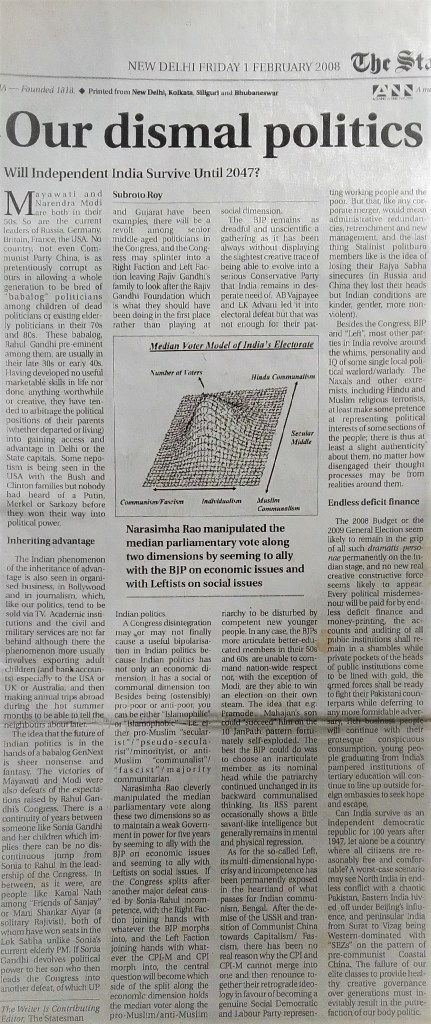It is now coming up to be 3 pm Indian Standard Time on May 13, the last day of India’s 2009 General Elections, and there are two hours left for the polls to close. I am happy to predict a big victory for the Congress Party, and Sonia Gandhi and her son Rahul will deserve congratulations for it.
How the victory takes shape is, I think, by their having won the median voter on both the economic and the secular-communal axes of Indian politics. (See my 2008 published graph on the Median Voter Model in Indian politics, available elsewhere here).
I have met Sonia Gandhi once, in December 1991 at her home, where I gave her a tape of her husband’s conversations with me during the first Gulf War in 1991. Her son and I met momentarily in her husband’s office in 1990-1991 but I do not recall any conversation. I have had nothing to do with her Government. Dr Manmohan Singh and I have met twice, once in Paris in the autumn of 1973 and once in Washington in September 1993; on the latter occasion, I was introduced to him and his key aides by Siddhartha Shankar Ray as the person on whose laptop the Congress manifesto of 1991 had been composed for Rajiv, something described elsewhere here. (I also gave him then a copy of the published book that emerged from the University of Hawaii perestroika-for-India project, Foundations of India’s Political Economy: Towards an Agenda for the 1990s, edited by myself and WE James.) On the former occasion, Dr Singh had kindly acceded to my father’s request to visit our then-home to advise me on economics before I started as a freshman undergraduate at the London School of Economics.
In May 2004 I was interviewed by BBC television in England and I praised the UPA in prospect — in comparison to the horrors of the Vajpayee-Advani regime (including my personal experience of it, when their Education Minister had sent an astrology-believing acolyte to supposedly run a scientific/technical institute).
Since 2005, especially in the columns of The Statesman, I have dispensed rational criticism of the UPA Government as harshly as I have criticised the BJP/RSS and the Communists. Principally, I believe they have got some (perhaps most) much of their economics (quite badly) wrong as well as their jurisprudence and foreign policy; they have also been willingly under the influence of the powerful organised lobbies and interest groups that populate our capital cities.
Even so, I think there is a large electoral victory in prospect for the Congress, and I send them my early congratulations. They have done enough by way of political rhetoric and political reality to maintain or enhance their vote-share; their oppositions on either side have both failed badly. The BJP may make some marginal gains especially in Bihar but they have generally done enough to lose the day. The CPM too will lose popularity especially in Bengal, and will never progress until they fire their JNU economists which they are never going to do.
So, Sonia-Rahul, well done!
But please try to improve your economics.
And, also, you simply must get Dr Manmohan Singh a seat in the Lok Sabha if he is to be PM — Ambedkar and Nehru and all their generation did not specify that India’s PM must be from the Lok Sabha because it was something totally OBVIOUS.
Subroto Roy
Postscript: Someone at a website has referred to my prediction above and remarked: “Perhaps the good doc is aware of the money in play”. The answer is no, I have absolutely no special information about any “money in play” on any side. My prediction is based on a layman’s observation of the campaign, as well as more specialised analysis of past voting data from the EC. In an earlier post, I pointed out the BJP had gotten some 17 million fewer votes than the Congress in 2004, and I asked if they had done enough to get enough of a net change in their favour. The answer I think is that they have not done so. To the contrary, I think there will be a quite large net change in favour of Congress thanks to a better-run and better-led campaign. Of course it is just a prediction that may be found to be incorrect.
SR
 And yes, of course, there have been demographic changes over five years so those changed parameters shall have affected the new outcome too (notice the INC’s emphasis on the “youth vote”).
And yes, of course, there have been demographic changes over five years so those changed parameters shall have affected the new outcome too (notice the INC’s emphasis on the “youth vote”).
